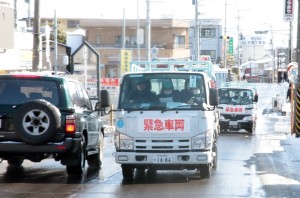 Following the Tohoku-Kanto Earthquake on March 11, television, radio, and newspaper coverage highlighted the serious shortages of water, food supplies, blankets, and fuel in the affected areas. A great many Tenrikyo followers, taking this disaster as their own concern, have been proactively working to assist evacuees as well as conducting activities to collect and deliver much-needed supplies to the affected areas. Below is a roundup of a few of those activities. (as of March 22)
Following the Tohoku-Kanto Earthquake on March 11, television, radio, and newspaper coverage highlighted the serious shortages of water, food supplies, blankets, and fuel in the affected areas. A great many Tenrikyo followers, taking this disaster as their own concern, have been proactively working to assist evacuees as well as conducting activities to collect and deliver much-needed supplies to the affected areas. Below is a roundup of a few of those activities. (as of March 22)
Churches and mission stations serve as evacuation shelters
Some Tenrikyo churches and mission stations located in the affected areas—despite having sustained damage themselves—served as temporary evacuation shelters for the people in their communities.
Sendai Grand Church, located in Sendai, Miyagi Prefecture, provided shelter for about 50 local residents from March 11 to 16. As a result of the earthquake, the church’s roof tiles were damaged and the wall around the church collapsed. However, the church’s worship hall—having been built on the second floor of a sturdy ferroconcrete structure as a precaution against tsunami—was able to serve as a shelter for about 50 people, including residents of a nearby welfare facility, who had initially taken refuge in a park across from the church. Thanks to the relief supplies that had been collected by Tenrikyo followers and delivered to Sendai Grand Church, the church could also provide the evacuees with meals and bedding. Electricity was restored in the community on the 15th, and the evacuees returned to their homes on the 16th, after expressing gratitude for the care they had been shown.
Aiyo Mission Station, which belongs to Aimachi Branch Church, is located in Ofunato City, Iwate Prefecture, which was devastated by huge tsunami waves. Designated by the municipal authorities as an evacuation center due to its location on high ground, the mission station is still providing shelter to about 40 evacuees. Relief supplies including food and kerosene have been delivered to the mission station on several occasions by Iwate Diocese’s Disaster Relief Hinokishin Corps. These items enabled the mission station to set up an emergency kitchen, which is feeding about 100 people, including local residents. (March 22)
Delivering a community’s sincere donations: Kako Grand Church
Kako Grand Church, located in Inami-cho, Hyogo Prefecture, began planning its relief activities immediately after the earthquake occurred on March 11. Deciding that they would deliver relief supplies to the affected areas, the church’s followers spent the following day collecting supplies from nearby churches and members of the local community, who had also made generous donations during the disaster caused by the Hanshin-Awaji Earthquake 16 years ago. This time, as well, the nearby followers and community members responded generously: on that one day alone, they donated 2 tons of water, 824 blankets, 120 kilograms (265 lbs.) of rice, 1,300 towels, and many other items. In addition, the owners of a sake brewing company and a lumber company offered the use of their trucks to transport the collected relief supplies. Then, on the evening of the 13th, eight members of the church’s Young Men’s Association chapter left for the disaster area with a water truck, a two-ton truck filled with supplies, and a microbus. Arriving in Sendai, Miyagi Prefecture, at a little past noon on the 14th, they unloaded some of the food supplies and blankets at Sendai Grand Church before continuing on to Fukushima Diocese Office in Fukushima City. Arriving at the diocese office on the evening of the same day, they distributed water to evacuees at a local community center.
Delivering relief supplies through subordinate churches: Nagoya Grand Church
Nagoya Grand Church, located in Owari-asahi City, Aichi Prefecture, has nine branch churches in Miyagi Prefecture, of which six are located in Kurihara City—where the magnitude-9 earthquake on March 11 was measured at the maximum of 7 on the Japan Meteorological Agency’s seismic intensity scale. Following the earthquake, the grand church promptly began making arrangements to deliver relief supplies to the area. On the 16th, 10 church members set out for the area with a two-ton truck and a four-ton truck filled with much-needed water, food, cooking devices, and various items to protect people from the cold. The group of relief workers from the grand church based themselves at the branch churches while distributing supplies and cooked food to residents in the neighborhood as well as to a home for the elderly. They also helped to straighten up the damaged sanctuaries at the churches.
Setting up an emergency kitchen: Saitama Diocese
By maintaining close contact with followers in tsunami-devastated areas, volunteers from Saitama Diocese have been delivering water, food items, and other daily necessities to those areas. On the 14th, they distributed three tons of water in Miyagi Prefecture, while basing themselves at an evacuation center in Kesennuma City and Ishiichi Branch Church in Ishinomaki City. On the 16th, they cooked 2,000 bowls of udon noodles for evacuees at Kesennuma Junior High School, one of the evacuation centers in Kesennuma City.
Collecting monetary donations in Taiwan: Mission Headquarters in Taiwan
On March 12, the day following the Tohoku-Kanto Earthquake, Tenrikyo Mission Headquarters in Taiwan embarked on a campaign to collect monetary donations for the affected areas. Besides placing an announcement in its Chinese Tenri newsletter, the mission headquarters had posters printed, which were distributed to churches and mission stations in Taiwan. The campaign, which is scheduled to continue through the end of April, had collected a total of NT$1,100,000 (US$37,610) as of March 22.




